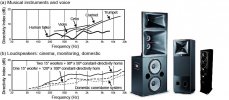Hi Floyd, I am glad you mentioned this. Your fond recollection, and purchase for own use, of the M1 Mirage
was used in another thread here to suggest you find omni speakers to be as good as any, perhaps even better ie Floyd Toole's choice from among all the speakers tested at the NRC in Canada, for use in his own home, (the same linked post even suggests that you are modifying the sound of 2-channel from your Revel Salon2's in your current setup via upmixing to capture some more of what the M1 did for you that the Revels can't), and prop up
an argument that omni speakers are the ultimate way to reproduce sound, to wit, "
Omnidirectional loudspeakers produce the most realistic musical soundstage in the home.... The superiority of the design is easily heard when in person, and when measured, particularly in the off-axis domains both vertically and horizontally. Live music and therefore sound propogation happens omnidirectionally, and is how our ear-brain mechanisms have evolved to understand sound. 98% of loudspeakers are designed incorrectly...(by not being omni)".
And
when I tried to state that you used the M1 as a special case solution to a 'special case' room, and that they are suboptimal in most cases, the ensuing to-and-fro focused more on whether I had exaggerated your room as "
virtually a giant echo chamber that just plain sounded bad" and the recordings of the day as "
too-often horrendously poorly recorded and placed large sections of the orchestra wholly in one speaker, he needed a loudspeaker that was really bad at soundstage reproduction and greatly blurred the sonic image", LOL, maybe I'm guilty as charged there, but it didn't negate my main point.
So, it is interesting the many different ways you get referenced, in support of both sides of a discussion!
PS Also
I suggested that sound sources are not omnidirectional, but it didn't seem to deflect the pro-omni-speaker lobby.
cheers

